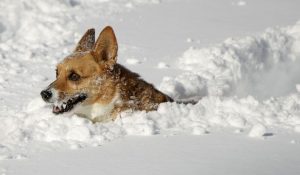
From Heavy
While Midwesterners brace themselves for even colder weather in the coming days than they’ve already been dealing with, Michigan and Wisconsin have already declared a State of Emergency and urged citizens to plan accordingly for the cold snap.
With areas of Wisconsin, Michigan and Illinois reaching temperatures of -50 degree Fahrenheit through Wednesday and Thursday, each state is warning citizens to take extra precautions when venturing outside, imploring people to limit exposed skin and wear as many layers as possible if forced to leave the house. Hundreds of school districts across both states have closed, as well as many government offices and business across the Midwest.
With frigid winds already blowing through the Midwest and expected to drop even further, many families are left wondering how they can protect their pets as well as themselves during such arctic, record-breaking cold snaps. Check out a list of ways you can keep your furbabies safe, courtesy of the American Society for the Prevention of Cruelty to Animals:
Limit Your Pet’s Time Outdoors
If you’re too cold to sit outside for lengthy periods of time, your pets probably are too. We understand that some pets enjoy the cold and snowy weather, but with windchills reaching in the negative fifties, serious damage can be done to paws and tails, among other areas of the body, and frostbite sets in incredibly quickly in small animals. Freezing cold temperatures can make animals disoriented, and they may get lost easier. Keep a close eye on pets while letting them outdoors, and limit their time spent outside as much as possible until temperatures rise again.
If you have an outdoor cat, bring him/her inside! Make a warm spot in the basement, or somewhere else if you are worried about the cat being indoors. There is a disturbing amount of dogs and cats found frozen to death because owners choose not to bring them inside and assume they can keep themselves warm. And take special care with smaller dogs, or dogs with short fur – they often need extra help when being let outside in such cold temperatures.
Bundle Them Up in Sweaters & Booties
Puppies and senior animals are so vulnerable in cold weather! Please make sure to limit their time outdoors.
When possible, especially with smaller pets, bundle your furbabies up with coats and sweaters, and especially with paw booties. This will help them retain their heat and avoid frostbite to the paws. If you don’t have pet booties, you can apply petroleum jelly or commercially-available organic wax balms to the paw pads for protection. Booties also prevent salt, sand and chemicals from irritating your pet’s paws, and with the amount of snow most of the Midwest has gotten recently, there is bound to be salt nearby. If you don’t have booties, wash and dry your dog’s feet after walks.
Avoid Bathing Pets While Temperatures Are Low
Although a bath might sound like just the right thing to help warm your pets up, bathing can dry out your pet’s skin and make it itchy and irritated. Try avoiding a bath until after the cold snap passes. Slipping a heating pad under a blanket is a good way to help keep them warm instead of a bath (obviously don’t leave the heating pad unattended). Also avoid haircuts until after it warms up a bit more; their fur helps retain their body heat. Trimming their fur to keep ice and other sand off their coats is fine however.
Give Extra Food & Water to Keep Skin From Drying Out
Giving a little extra food, and especially extra water, during a cold snap is essential to keeping your pet healthy. When it’s really cold outside, pets burn more calories, so an extra feeding or two will help boost their stamina, while the extra water will keep their skin and coat from drying out. Also, keep a close eye out for patches of antifreeze and other chemicals; antifreeze smells sweet to dogs and cats and is deadly when ingested, and salt de-icer’s are toxic and often ingested by licking paws. If possible, look for salt-free ice melters that are safe for pets.
NEVER Leave Your Pet in the Car or Outside
This goes without saying, although it never hurts to repeat: NEVER leave your pets in the car, or for long periods of time unattended outdoors during bad weather. Once a car’s ignition has been turned off, cold temperatures can quickly infiltrate the vehicle, creating a freezer-like environment, just like they do in the summer when it’s hot. Avoid traveling with your pet unless absolutely necessary while it’s so cold, even if you have to pop into the store for “just a minute,” or risk your pet freezing to death.
Keep Pets Away From Frozen Bodies of Water
Keep your pet away from frozen ponds, lakes or other bodies of water that may not be able to support his weight – if they fall through, hypothermia can set in minutes, leaving you very little time to seek medical attention. Also, do not let your dogs off the leash while on walks if you can avoid it. Dogs frequently lose their scent in snow and ice, which could cause them to panic in a snowstorm and run away. More dogs are lost during the winter than during any other season.
When returning home, wipe snow and ice off your dog’s belly, legs, and paws with a warm wash rag to help avoid any irritation or dangerous chemicals from being ingested (see salt above).
Be Aware of Heat-Seeking Strays
PSA: As the weather gets cold, remember that animals like to snuggle in the warmth of your car engine. Before starting up, tap your hood a couple times.
Many strays, especially cats, seek out heat during snowstorms and cold spells. Be on the lookout for cats crawling under the hoods of cars and under wheel wells. It’s advisable to bang on the hood or fender of your vehicle before starting the car, or to honk the horn a few times to give them a chance to escape before turning on the engine.
Give Your Pets a Warm Place to Sleep
Whether you allow your pet to sleep in your bed with you or not, giving your pets a warm place to curl up is essential during freezing winter weather. If they are not allowed on the furniture or bed, providing a pet bed or a warm blanket to snuggle under on the floor makes a huge difference between shivering all night and being comfortably warm. Try to keep their beds as far from drafty doors and windows as possible.
Don’t Forget About Your Farm Animals
Just because they live outside doesn’t mean they aren’t susceptible to frostbite and hypothermia. Outdoor animals, especially farm animals, need extra attention and care during arctic weather too, especially if you don’t have access to a heated barn. Making sure they have extra, quality food will help produce body heat, and keeping them hydrated helps their skin from drying out. According to National Hog Farmer, a good rule of thumb involves increasing nutrition requirements approximately 1% for every degree the temperature drops below 20 degrees F. For horses, their nutritional needs increase when temps drop below 45 F.
For large animals, providing a dry place to get out of the wind, such as a barn or a three-sided shelter will help keep them safe during bad weather. Enclosed spaces to help retain body heat are the most advisable, and keeping them dry and providing warm bedding is essential to insulating them from frostbite. Smaller animals need smaller spaces to retain body heat, so adjust accordingly.
Keep fresh water available at all times. To help avoid freezing, stock tank heaters and frost-proof waterers are useful, but if you do not have those available, giving them lukewarm water multiple times a day will also work.
How You Can Help Strays & Wildlife
Your pets aren’t the only animals you can help as the cold moves in. Although most wildlife knows how to keep warm if it gets too cold, you can still help out by filling a heavy, nonmetal bowl with water, which will help birds, squirrels, rabbits and other small animals survive the brutal temperatures. Make sure to break the water’s surface a few times per day if it freezes, and if that is impossible (if it’s frozen solid), replace the water frequently. Providing extra food for stray cats and dogs is immensely helpful as well, and can help them survive when food scraps are sparse.
For stray cats and dogs, making a makeshift shelter out of old storage bins works wonders. By cutting a hole in the bin, insulating the inside with old blankets, newspapers or straw, and securing the lid on top while keeping a door flap on the bin, you can provide a shelter for strays in your neighborhood looking to get out of the bitter wind. A cardboard box wrapped in a waterproof tarp or garbage bag is also useful, and putting a second, smaller box or bin inside the outer shell will insulate the space even more. We recommend using straw to help keep moisture out of the makeshift shelter, and sprinkle a little bit of catnip or leave dog treats inside to help entice the animals in. Also make sure to face the entryway away from the wind, and, when possible, elevate it off the cold ground, or put something beneath the bin to keep off the cold concrete.
Another way to help is contacting authorities when you see an animal – whether a pet or a stray – freezing outside. Most shelters or rescues will make an effort to pick up a stray, and police should be contacted immediately if you see somebody leaving their pet outside during such frigid weather. If you are able, opening your garage or basement up to a stray during cold weather is also helpful, but obviously not always an option, so calling a rescue or shelter is the next best option.
If You Can’t Bring Them Inside, Seek Out a Shelter That Can Help Care For Your Pet Until You Are Able
If you cannot for any reason bring your pet inside, please seek out a shelter that can. Whether a friend, relative, or a nearby animal shelter, there are options available for you. Some shelters are even offering to care for your pets during the cold spell if you are unable to do so, and will return your pets once the temperatures rise again.








